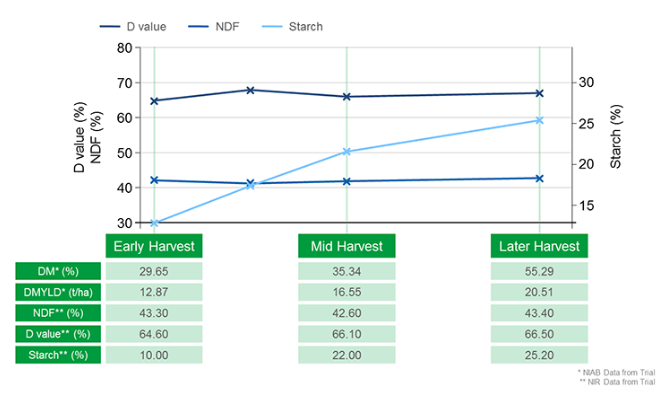Making Wholecrop Cereal or Small Grain Silage
The practice of growing wholecrop cereals or small grains — such as barley, sorghum, triticale, oats and wheat — for silage is increasing in popularity due to the flexibility of the crop and improved inoculant technology that allows this aerobically unstable feedstuff to be ensiled. Cereals provide a wide harvest window for forages and concentrate. Along with their consistent nutritional quality and yield, cereals can be a flexible addition to most livestock and production systems.
Cereals have the potential to create a starch-rich forage crop with a high dry matter (DM) yield from a single-cut system. Producers can make well-preserved silages with high energy — or starch — and low acid levels. Wholecrop cereals can provide a useful source for effective fiber, which is essential for maintaining healthy rumen function. Wholecrop cereals have a low protein content, making them an ideal balancer for grass silage. It can be a low-energy feed, which can reduce the energy density of the diet. However, wholecrop silages tend to promote higher DM intakes.
Wholecrop cereals also can be grown in conjunction with a legume crop. More information is available on that practice in other sections.
Maturity
By varying harvesting dates, producers can influence the yield and nutritional analysis of the wholecrop. This gives producers an opportunity to take stock of their current situation and maximize the contribution from forage.
Cutting wholecrop forage earlier will produce feed with high neutral detergent fiber digestibility (NDFd) and lower starch. Cutting later will produce a feed with higher starch and lower NDFd. The overall digestibility of wholecrop or small-grain silages remains fairly consistent regardless of harvest date.
| Harvest Options | Crop DM % | Crop Color | Stem Color | Ear Color | Grain Texture |
|---|---|---|---|---|---|
| Fermented wholecrop | 30-35 | Green | Green | Green | Soft cheese, some milky |
| Fermented wholecrop | 35-40 | Green | Green going yellow | Green going yellow | Soft cheese, no milk |
| Fermented wholecrop | 40-45 | Green/Yellow | Mostly yellow, some green | Mostly yellow | Soft cheddar cheese |
| Fermented wholecrop (processed grains) | 45-50 | Yellow/Green | Mostly yellow | Yellow | Hard cheddar cheese |
For example, winter wheat can be harvested early to obtain a low DM crop that is high in digestible fiber and low in starch. On the other hand, a later-cut crop will have more starch but lower digestible fiber levels.

Dry Matter
Wholecrop or small grain silage can be harvested at the green stage — between 28-35% DM — to help balance diets high in corn silage, diets with late-cut grass silage or diets high in rumen fermentable carbohydrates.
A mid-season cut — about 35-45% DM — can provide good levels of digestible fiber and starch. This type of wholecrop is recommended when producers are balancing diets with:
- 50/50 grass and corn silage
- Highly digestible grass silage
- Very little or no corn silage
- High in rumen-fermentable protein from clovers, lucerne or alfalfa forages
Later season wholecrop silage — above 45% DM — will contain high levels of structural fiber and starch. The grain is tough at this stage and will require processing. Therefore, the starch will be more rapidly fermentable in the rumen. For this reason, it should be fed at restricted levels to avoid metabolic problems like Sub-Acute Ruminal Acidosis (SARA) in cattle.
Chop Length
Special attention should be given to the length of cut on small-grain silage. Chopper knives should be kept sharp and adjusted for a 3/8 to 1/2 inch, or 1.9 to 12.7 cm., cut for good packing of the ensiled material. Long stems can be a direct channel for feeding oxygen into the silage, causing spoilage. The addition of 100 to 200 pounds, or 45 to 90 kg., of ground corn per ton of small grain silage will improve the quality and feed value of silage.
Challenges
Cereals rapidly advance in maturity. In some areas, there may be just a 10- to 14-day window for harvesting at the dough stage of plant development.
Nitrates can accumulate in small-grains cereals because of drought, hailstorms or late frosts. Oat hay is more likely to have a high nitrate level than any other small-grain cereals.
A crop-specific forage inoculant should be used for small grains if harvested during cooler temperatures. These conditions may reduce lactic acid bacteria (LAB) populations needed to properly store silage. For higher DM crops, choose an inoculant that helps prevent aerobic spoilage, which is the main challenge.








